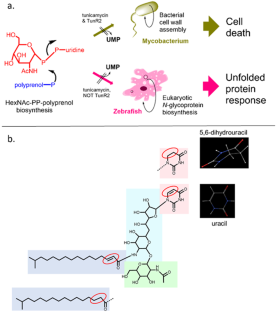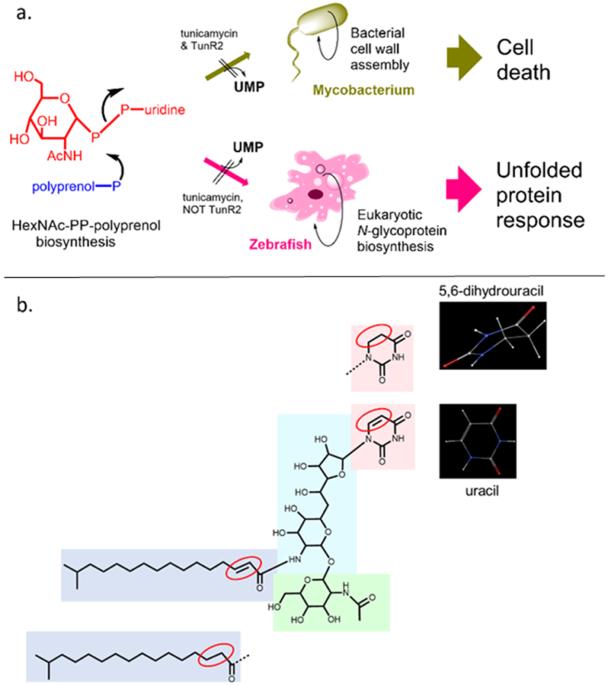The tunicamycin derivative TunR2 exhibits potent antibiotic properties with low toxicity in an in vivo Mycobacterium marinum-zebrafish TB infection model
IF 2.1
4区 医学
Q3 BIOTECHNOLOGY & APPLIED MICROBIOLOGY
引用次数: 0
Abstract
Tunicamycins (TUN) are well-defined, Streptomyces-derived natural products that inhibit protein N-glycosylation in eukaryotes, and by a conserved mechanism also block bacterial cell wall biosynthesis. TUN inhibits the polyprenylphosphate-N-acetyl-hexosamine-1-phospho-transferases (PNPT), an essential family of enzymes found in both bacteria and eukaryotes. We have previously published the development of chemically modified TUN, called TunR1 and TunR2, that have considerably reduced activity on eukaryotes but that retain the potent antibacterial properties. A mechanism for this reduced toxicity has also been reported. TunR1 and TunR2 have been tested against mammalian cell lines in culture and against live insect cells but, until now, no in vivo evaluation has been undertaken for vertebrates. In the current work, TUN, TunR1, and TunR2 are investigated for their relative toxicity and antimycobacterial activity in zebrafish using a well-established Mycobacterium marinum (M. marinum) infection system, a model for studying human Mycobacterium tuberculosis infections. We also report the relative ability to activate the unfolded protein response (UPR), the known mechanism for the eukaryotic toxicity observed with TUN treatment. Importantly, TunR1 and TunR2 retained their antimicrobial properties, as evidenced by a reduction in M. marinum bacterial burden, compared to DMSO-treated zebrafish. In summary, findings from this study highlight the characteristics of recently developed TUN derivatives, mainly TunR2, and its potential for use as a novel anti-bacterial agent for veterinary and potential medical purposes.


在海洋分枝杆菌--斑马鱼结核病体内感染模型中,妥尼霉素衍生物 TunR2 表现出低毒性的强效抗生素特性。
Tunicamycins (TUN) 是一种定义明确的链霉菌天然产物,可抑制真核生物中的蛋白质 N-糖基化,并通过一种保守的机制阻止细菌细胞壁的生物合成。TUN 可抑制多烯基磷酸-N-乙酰-己糖胺-1-磷酸转移酶(PNPT),这是细菌和真核生物中都存在的一个重要酶家族。我们以前曾发表过化学修饰 TUN 的开发成果,称为 TunR1 和 TunR2,它们对真核生物的活性大大降低,但仍具有强大的抗菌特性。我们还报告了毒性降低的机制。TunR1 和 TunR2 已针对哺乳动物培养细胞系和昆虫活细胞进行过测试,但迄今为止,尚未对脊椎动物进行过体内评估。在目前的研究工作中,我们利用一个成熟的海洋分枝杆菌(M. marinum)感染系统(研究人类结核分枝杆菌感染的模型),研究了 TUN、TunR1 和 TunR2 在斑马鱼体内的相对毒性和抗分枝杆菌活性。我们还报告了激活未折叠蛋白反应(UPR)的相对能力,这是 TUN 处理所观察到的真核毒性的已知机制。重要的是,与 DMSO 处理的斑马鱼相比,TunR1 和 TunR2 保留了它们的抗微生物特性,这体现在 M. marinum 细菌负担的减少上。总之,本研究的结果突出了最近开发的 TUN 衍生物(主要是 TunR2)的特性,以及其作为新型抗菌剂用于兽医和潜在医疗用途的潜力。
本文章由计算机程序翻译,如有差异,请以英文原文为准。
求助全文
约1分钟内获得全文
求助全文
来源期刊

Journal of Antibiotics
医学-免疫学
CiteScore
6.60
自引率
3.00%
发文量
87
审稿时长
1 months
期刊介绍:
The Journal of Antibiotics seeks to promote research on antibiotics and related types of biologically active substances and publishes Articles, Review Articles, Brief Communication, Correspondence and other specially commissioned reports. The Journal of Antibiotics accepts papers on biochemical, chemical, microbiological and pharmacological studies. However, studies regarding human therapy do not fall under the journal’s scope. Contributions regarding recently discovered antibiotics and biologically active microbial products are particularly encouraged. Topics of particular interest within the journal''s scope include, but are not limited to, those listed below:
Discovery of new antibiotics and related types of biologically active substances
Production, isolation, characterization, structural elucidation, chemical synthesis and derivatization, biological activities, mechanisms of action, and structure-activity relationships of antibiotics and related types of biologically active substances
Biosynthesis, bioconversion, taxonomy and genetic studies on producing microorganisms, as well as improvement of production of antibiotics and related types of biologically active substances
Novel physical, chemical, biochemical, microbiological or pharmacological methods for detection, assay, determination, structural elucidation and evaluation of antibiotics and related types of biologically active substances
Newly found properties, mechanisms of action and resistance-development of antibiotics and related types of biologically active substances.
 求助内容:
求助内容: 应助结果提醒方式:
应助结果提醒方式:


